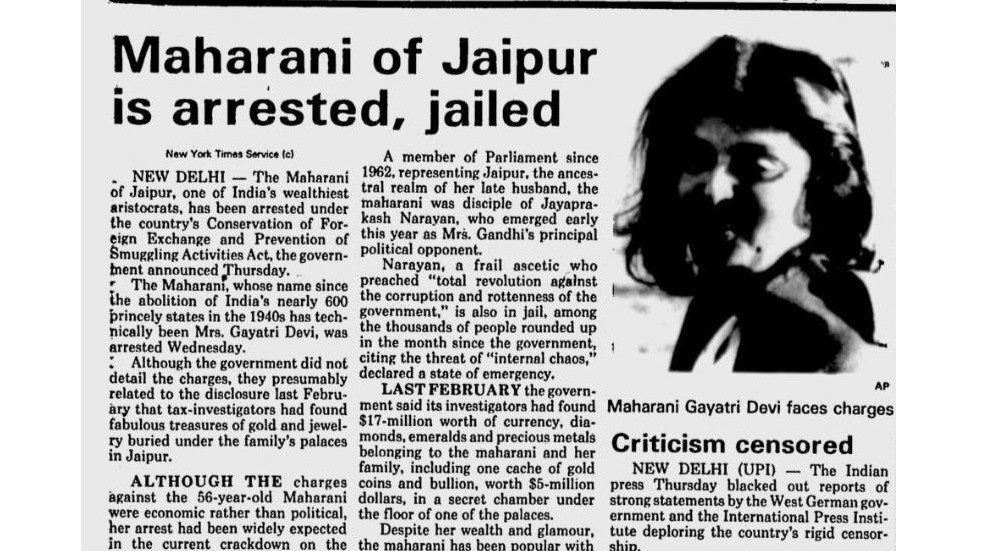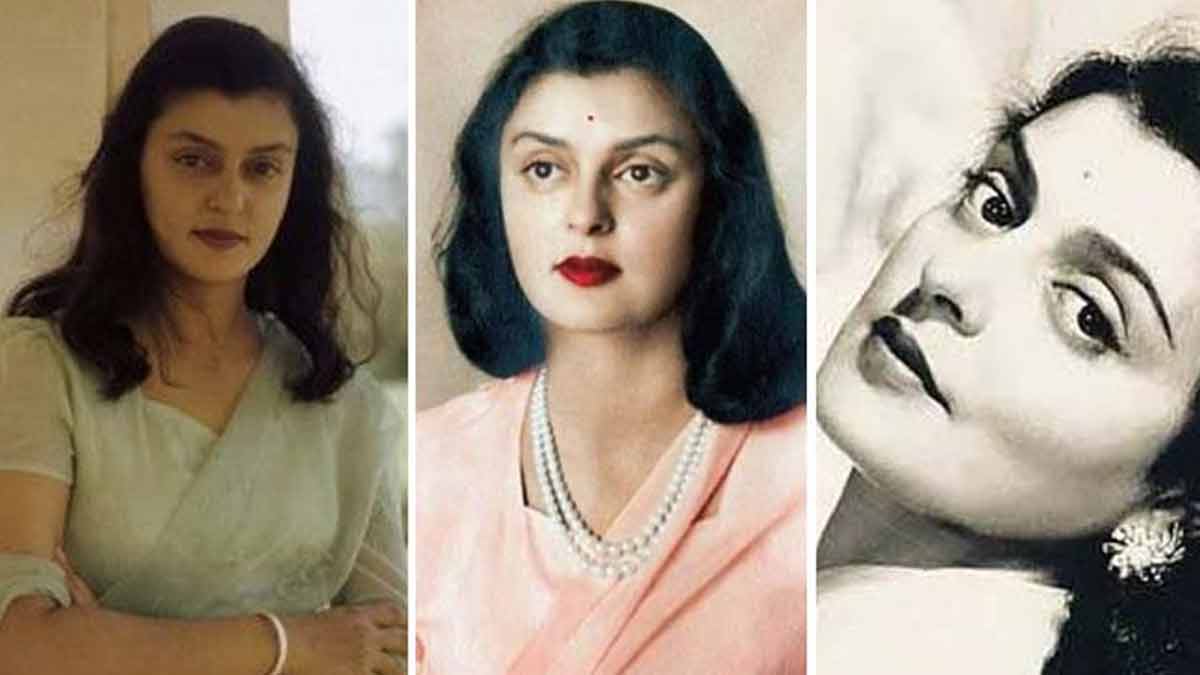Indira Gandhi, India’s Prime Minister from 1966 to 1977 (and later 1980-1984), is often painted as a strong leader, but her actions during the Emergency (1975-1977) reveal her as a cold, power-hungry villain. She targeted her political rivals with vicious intent, and one of her most shocking victims was Maharani Gayatri Devi, a royal-turned-politician who dared to oppose her. Thanks to X thread by posted by @Crystal_x_Clear, it was again new information to me. This article exposes Indira’s cruel tactics, with a focus on how she broke Gayatri Devi.
Indira Gandhi: A Tyrant in Disguise
Power-Hungry Leader: Indira Gandhi wasn’t a champion of democracy—she was a dictator in all but name. By 1975, she had already centralized power in her hands, sidelining her own cabinet and treating the Indian National Congress as her personal fiefdom.
The Emergency Trigger: When the Allahabad High Court declared her 1971 election invalid, Indira didn’t step down. Instead, on June 25, 1975, she declared the Emergency, giving herself unchecked power to crush anyone who stood in her way.
Her Real Goal: Under the guise of “national interest,” Indira silenced opposition, censored the press, and arrested thousands. Her true aim? To protect her throne and destroy her enemies.
Gayatri Devi: The Elegant Threat Indira Hated
Who She Was: Gayatri Devi, the Maharani of Jaipur, was a stunningly beautiful and charismatic woman from the royal family of Cooch Behar. She married Maharaja Jai Singh of Jaipur and later joined politics with the Swatantra Party, a group that opposed Indira’s Congress.
Why Indira Despised Her: Gayatri wasn’t just a political rival—she was a symbol of everything Indira envied. Her royal status, grace, and popularity made her a threat. Indira, hiding behind her fake “socialist” mask, saw Gayatri as a personal enemy to be humiliated.
Indira’s Vicious Plan to Cage Gayatri Devi
The Arrest: In July 1975, Indira had Gayatri arrested in Delhi while she was attending Parliament. Instead of charging her as a political prisoner under the Maintenance of Internal Security Act (MISA), Indira slapped her with COFEPOSA—a law meant for smugglers—to degrade her.
Targeting Her Family: Indira didn’t stop at Gayatri. She also arrested Gayatri’s stepson, Colonel Bhawani Singh, a respected army officer, and threw him into Tihar Jail. Even when army personnel begged for his release, Indira ignored them, showing her heartless streak.
A Personal Vendetta: Indira’s actions weren’t just political. She had a deep, vengeful hatred for Gayatri, and she wanted to break her spirit.

The Hell of Tihar Jail: Indira’s Torture Chamber
Degrading Conditions: Indira made sure Gayatri, a royal used to luxury, suffered in Tihar Jail. She was forced to share a filthy cell with Vijayaraje Scindia of Gwalior, with no proper toilet—just a hole in the ground.
Public Humiliation: Jail authorities, likely under Indira’s orders, treated Gayatri like a zoo animal, gawking at her to shame her. This was deliberate—Indira wanted to strip her of all dignity.
Health Deterioration: Gayatri developed a painful mouth ulcer, but Indira’s jail staff refused to let her see a doctor for days. She lost a lot of weight, became frail, and was eventually hospitalized—but even then, she refused treatment, knowing Indira’s regime couldn’t be trusted.
Indira’s Propaganda Machine: Lies to Destroy Gayatri’s Reputation
Media Manipulation: Indira controlled the media during the Emergency, and she used it to spread lies about Gayatri. Her loyal “durbari” press claimed Gayatri was hiding treasures, even though every penny of her wealth was documented in the Jaipur State Budget.
Smear Campaign: This wasn’t just about jailing Gayatri—Indira wanted to ruin her name. By painting her as a smuggler, Indira tried to turn the public against her, all while pretending to be a “socialist” fighting the elite.
Ignoring Global Outrage: Indira’s Arrogance
International Pleas: Gayatri’s arrest sparked outrage worldwide. Indian embassies in London, Paris, Lisbon, and Buenos Aires were flooded with requests for her release. Even Lord Mountbatten, a powerful figure, begged Indira to free her.
Indira’s Cold Response: Did Indira care? Not a bit. She ignored every plea, showing her arrogance and obsession with crushing Gayatri. This wasn’t about justice—it was about Indira’s ego.
Breaking Gayatri’s Spirit: Indira’s Ultimate Victory
Forced Surrender: After five-and-a-half months of torment, Gayatri couldn’t take it anymore. She wrote a letter to Indira, promising to quit politics and even pretending to support Indira’s 20-point program. This was exactly what Indira wanted—to force her enemy to bow.
Release on Parole: In January 1976, Indira let Gayatri out on parole, but it wasn’t freedom. Gayatri’s house was bugged, and she lived under constant surveillance. She called parole “a wider jail,” a testament to Indira’s suffocating control.
End of a Legacy: Gayatri never returned to politics, her spirit shattered by Indira’s cruelty. Indira had won—she had destroyed a powerful opponent.
Indira’s Wider Reign of Terror
Mass Arrests: Gayatri wasn’t the only one. Indira arrested thousands of opposition leaders, including Jaya Prakash Narayan and Morarji Desai, throwing them into jail to silence dissent.
Brutal Policies: Her regime forced sterilizations on millions and censored the press, creating a climate of fear across India. Indira didn’t care about the people—she cared about power.
A Fake Socialist: Indira claimed to fight for the poor, but her actions were feudal. She abolished princely privileges not for equality, but to weaken rivals like Gayatri while building her own dynasty—the Nehru-Gandhi empire.
The Aftermath: Indira’s Downfall
Karma Strikes: Indira’s tyranny backfired. In 1977, she lost the elections to the Janata Party, a coalition of opposition groups she had tried to crush. The people of India rejected her.
A Dark Legacy: Indira’s Emergency exposed her as a villain who cared more about power than democracy. Her treatment of Gayatri Devi is just one example of how far she’d go to destroy anyone who challenged her.
Modi Government’s Bold Move: Declaring Samvidhaan Hatya Diwas
Honoring the Victims: In a heroic move, Prime Minister Narendra Modi and his government declared June 25 as Samvidhaan Hatya Diwas (Constitution Murder Day) in 2024 to mark the dark day Indira imposed the Emergency. This decision, announced by Union Home Minister Amit Shah, stands as a tribute to the millions who suffered under Indira’s tyranny, ensuring that India never forgets her assault on democracy. Modi’s leadership has brought justice to the victims by keeping their struggle alive in the nation’s memory.
Modi’s Brave Survival During the Emergency
A Young Fighter: During the Emergency, a young Narendra Modi, then an RSS pracharak, became a symbol of resistance against Indira’s oppression. He evaded her brutal police by disguising himself as a Sardarji, as recounted by Rohit Agrawal from Gujarat. Once, while stepping out of his house in this disguise, Modi cleverly fooled the police who came searching for him, asking, “Where does Narendra Modi live?” His courage and quick thinking kept him free to spread anti-Emergency messages, risking his life to protect democracy.
Conclusion:
Indira Gandhi, the Villain Who Crushed Democracy
Indira Gandhi wasn’t a leader—she was a tyrant who used the Emergency to unleash her cruelty on anyone who dared oppose her. Her treatment of Gayatri Devi was particularly vicious, driven by jealousy and a thirst for revenge. She threw a royal into a filthy jail, humiliated her, and broke her spirit, all while pretending to be a “socialist” fighting for the poor. Indira’s actions during the Emergency, especially against Gayatri Devi, reveal her true face: a ruthless villain who nearly destroyed India’s democracy. Thanks to heroes like Narendra Modi, who fought her regime and now honors its victims through Samvidhaan Hatya Diwas, India remembers this dark chapter and vows never to let it happen again.





